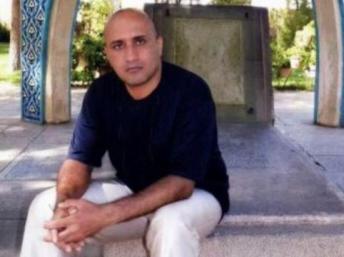Newly Disclosed Medical Examiner Report Confirms Sattar Beheshti Died of Internal Bleeding

A source told the International Campaign for Human Rights in Iran that a year after the death of Sattar Beheshti in custody, Beheshti’s family has learned of the existence of a Medical Examiner’s report stating his cause of death as hemorrhaging in his lungs, liver, kidneys, and brain.
The source told the Campaign that the family only learned about the Medical Examiner report one year after Beheshti’s death, after the 3,000 page case file was sent to the Criminal Court. “This is a report from one of the Medical Examiner doctors which was sent to the autopsy hall of the Medical Examiner last year; but Sattar’s family and lawyer were not allowed to read the case file until October this year, when it was sent to the Court, and were hence unaware of it,” said the source.
“In October [2013], Sattar Beheshti’s lawyer was able to receive permission from the Court to photocopy the Medical Examiner’s opinion, but because we couldn’t understand the medical expressions used in the report, we showed it to several specialist physicians. The specialists explained that in this report it is stated that Sattar suffered hemorrhaging in his lungs, liver, kidneys, and cerebellum and the doctors agreed unanimously that Sattar died as a result of this hemorrhaging,” the source added.
“In its report last year, the Medical Examiner said that the death was probably caused by stress; however, a year later we realized that there was a report by one the Medical Examiner doctors, stating Sattar’s cause of death as internal bleeding,” said the source.
In a July 9 interview with Mehr News Agency, the Head of the Medical Examiner Organization said that according to his organization’s final report, the blows Sattar Beheshti received were not fatal and could not have caused his death. Dr. Ahmad Shojaee also said that there had not been any indications in the toxicology reports, either which could have indicated death by unnatural causes.
In a November 2012 article, the International Campaign for Human Rights in Iran reported a Beheshti family member’s description of his body just before burial. “There was a large dent in his head and they had put plaster over his head. His face was swollen. As soon as they untied his shroud, blood splattered on the shroud from the side of his right knee. As soon as they untied his shroud it became completely bloody, and there were signs of an autopsy on his body, as well,” the source told the Campaign.
Sattar Beheshti, 35, a laborer and blogger, was arrested on October 30, 2012, by Iran’s Cyber Police and died under torture by his interrogator on November 3, 2012. His body was buried at Robat Karim Cemetery near where he lived. According to public death records at Tehran’s Behesht-e Zahra Cemetery, Sattar Beheshti’s date of death was November 3, 2012.
After news of Sattar Beheshti’s death was published, 41 Evin Prison political prisoners published a letter on Kaleme website and stated that Sattar Beheshti had been held at Evin Prison’s Ward 350 on October 31 and November 1, 2012, and that signs of torture could be seen all over different parts of his body.
The indictment against his killer, handed down by Branch 1057 of Tehran penal court, is for “quasi-intentional murder,” which has met with the lawyer and the Beheshti family’s objection.
In an October 2013 interview with the International Campaign for Human Rights in Iran, Gohar Eshghi, Sattar Beheshti’s mother, said that the indictment issued for her son’s prison death case for “quasi-intentional murder” was unexpected. “We’re really disappointed with the indictment. Up until the time the indictment was issued, every time we saw Mr. Shahriari, the case’s Investigative Judge, in the meetings he spoke of Sattar’s murder, he always told us, ‘You must forgive Sattar’s murderer, as [Imam] Ali did.’ He said [the murderer] is also a young man with a family. But, how it is now that an indictment for ‘quasi-intentional murder’ has been issued, I don’t know. All their efforts are focused on the murderer, who is an interrogator, not to be punished,” Gohar Eshghi said.
After repeated objections by Sattar Beheshti’s lawyer, the case was returned to Shariar Investigative Court for completion for a final determination of whether his murder was “quasi-intentional murder” or “intentional murder.”






